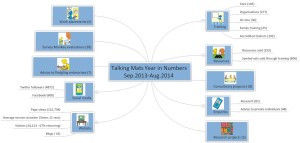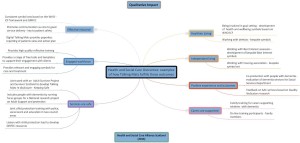We are very grateful to Rhona Matthews for sending us this moving blog.
‘‘I met with Katie, the worker at Perth Young Carers who did the Talking Mats training and she told me this story:
It is recognised that there are many positive outcomes from being a carer.
For some young people helping care for a sibling can bring confidence, develop feelings of closeness to family and increase self esteem. However it can also add stresses and strains. Expressing frustrations or anger can be difficult and feel like a betrayal.
Using Talking Mats can make it easier to say the things that might cause upset. Using the Children and Young Person’s resource, a young person disclosed to a worker that the one aspect she was not happy about when helping look after her brother, was administering medication. She had seen this being done in hospital by injection and did not like the thought of having to do it. She was happy with all other aspects of helping with his care. The worker fed this back to her parents and they all agreed not to expect her to do this.
The worker felt that this issue would not have been highlighted without the Talking Mats.”
It’s that time again when we have to write our Annual Report. This year we decided to make it (hopefully) more interesting and informative to read and (definitely) more enjoyable to write. So we have done it in the form of mind maps.
The first is a summary of all that we have achieved in the past year. We have broken it down into the various strands of our Social Enterprise business. Click on the mind map to be able to read it!
The second is an attempt to measure the social impact that Talking Mats has – never an easy thing to quantify.We have based it on Health and Social Care Outcomes used by the Health and Social Care Alliance Scotland 2013. Click on mind map.
We were delighted to receive this comment – “You can tell they are communication professionals. No waffle – really clear and just what you want to know. The best example of an annual report I have ever seen!”
Please let us know if you have any innovative ways of presenting reports
Thanks to Andrea McQueen from Australia for this lovely blog describing the Good Things Project which shows how good communication is central to active participation for people with intellectual disabilities
Across the world, many thousands of people with intellectual disabilities live in group homes. These are houses in the community shared by about four to six people with disabilities. Many of these people have communication difficulties of various sorts.
Communication is essential to many activities both within the home (e.g. making a shopping list, choosing what to watch on TV, letting your house mates know when you need some space) and beyond (e.g. developing and maintaining friendships; participation in education, employment and leisure). For many group home residents, participation in these activities relies on access to appropriate augmentative communication systems, and to trained staff who can support their use.
In twenty years working as a speech pathologist in Australia I have been in and out of a lot of group homes. Some do things better than others. Some value communication more than others. Some group home staff routinely use augmentative communication systems, such as Talking Mats, Key Word Sign and pictorial timetables. Unfortunately many do not. Each time I leave a group home, I ask myself the same question: “Could I live here?”
When I first came across the Roydon Street group home here in Melbourne I was impressed. This is a house where communication is respected, where people are listened to, and where genuine choices are offered. It’s not perfect, but it passes my simple test – it is a place where I could imagine living a good life.
I wanted to share the philosophies and practices of Roydon Street around the world. I hoped to influence other group homes to adopt the same simple strategies for their residents. So I sought funding and made a video – Good Things.
The Good Things video aims to show how simple communication strategies can contribute to a good quality of life for people with intellectual disabilities in group homes. It demonstrates how a culture of respect and autonomy can develop when staff understand how to listen to clients and support their communication methods. It shows what is possible in a sector that gets a lot of negative publicity.
Good Things was funded by the Victorian Department of Human Services, and the closed captions on the video were funded by the City of Bayside. The video is the result of a partnership of many agencies and individuals. Special thanks to the residents and staff at Roydon Street. Good Things was released on YouTube in March 2014, and to date has had more than 800 views in 17 countries (not quite keeping pace with Lady Gaga!). It’s a small project, but I hope it has made a difference. I know the team at Talking Mats shares the passion for improving the lives of people wherever they live, and I would love to hear from others with an interest in this area.
Click here to see the Good Things video
Andrea McQueen
Inner South Communication Service
Email: amcqueen@cbchs.org.au
Twitter: @aj_mcq
We are looking for another Associate to work with the Talking Mats team in Stirling (3 days per week). Talking Mats Ltd is a Social Enterprise which is expanding and developing into new areas and topics. The job will contribute to training, to the ongoing development of resources and to research and consultancy. We are looking for someone with real enthusiasm and experience of using Talking Mats who will bring good networking skills and creative ideas to develop Talking Mats in other sectors.
Please click here for the detailed job specification TM associate
If you are interested in joining a dynamic, creative and well respected team please send your CV and cover letter to: info@talkingmats.com.
The closing date for applications is Wednesday 3rd September and the interviews will be held on Friday 12th September
We are delighted with the response to our new Talking Mats symbols. They created a real buzz at the ISAAC (International Society of Augmentative and Alternative Communication) Conference in Lisbon last week.” Its so good to see something fresh and engaging” , “These are awesome”
Over the past few years we have been looking at symbols in a new way and have used our specialist skills from clinical practice, research and language structure to underpin their development. These skills, in partnership with a leading comic artist, www.adammurphy.com , have enabled us to design our symbols, making sure that they are:
- Unique
- Attractive and fun
- Simple but represent concepts clearly
- Distinguish between concrete and abstract concepts
- Show full body, not stick figures
- Acceptable in terms of age and ethnicity
- Balanced between male and female
- Provide additional visual clues within topics to support understanding
Talking Mats does not require people to select and ‘name’ symbols – the important feature is that the symbols act as a support to hang meaning on. In this way people can understand and use the symbols to express their views .
To determine the size and colour of the symbols, we have used a pragmatic approach as follows:
A search of the literature showed that very little empirical research has been written about optimal symbol size and colour for different client groups. However several leading graphic and cartoon designers use yellow as this is easily recognisable, attractive and ethnically neutral e.g. Simpsons, Lego
- Our artist advised us that cool colours such as blue recede into the background visually whereas warm colours such as yellow stand out more
- We believe it is important to include text as this provides additional input for many people e.g. many people with dementia can read.
- From discussion with colleagues and reading learning disability literature we decided that Arial, san serif point 14 would be the clearest font
- We experimented with various sizes, using very large symbols on one dementia project. However we found that very large symbols are too distracting and limit the number of symbols that can be used on a mat. Following piloting with older people in care homes we determined that the optimal size for using with Talking Mats is 5.5 square cm.
- We ran focus group discussions with speech and language therapists, people with learning disability, people with aphasia and people with dementia. The focus groups presented participants with symbols of different styles, size and colours. The resulting responses plus our literature search led us to the current symbols in terms of design, size and colour.
- We then piloted the symbols in several settings including a day centre with adults with complex physical and cognitive disabilities, a care home with people with dementia and a secondary school with children with additional support needs. In all of these setting almost all participants were able to see, recognise and use the symbols appropriately.
- We made a conscious decision not use photos because photos often have too much detail on the one hand or conversely can be too specific… but that’s a topic for another blog!
We are constantly extending the range of symbols and are currently working on a resource for helping people to consider their Eating and Drinking. We are also working on providing additional visual clues within topics to help people understand concept more easily e.g. emotions are represented within a cloud border. e.g this poor guy is feeling guilty
We are really excited that our new symbols are now being used by 2 organisations outside the field of disability to help students and graduates reflect on their skills,strengths and weaknesses.
 Online training login
Online training login 






